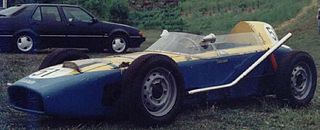Top Qs
Timeline
Chat
Perspective
Formula Junior
Former Single-Seater Racing Championship From Wikipedia, the free encyclopedia
Remove ads
Formula Junior was an international single-seater motor racing category that existed between 1958 and 1963. Devised by Italian motorsport promoter Count Giovanni "Johnny" Lurani, the formula was created as an accessible training ground for young drivers advancing from karting or amateur competition to professional-level open-wheel racing. Regulations required the use of production-based engines and components sourced from small road cars, which helped contain costs and encouraged participation by privateers and smaller manufacturers.[11]




The category quickly gained traction in Europe and the United States, evolving from a national class in Italy to an internationally recognized formula. While early success came from front-engined Italian cars such as those produced by Stanguellini, British constructors including Lotus, Cooper, and Brabham soon rose to prominence through the adoption of lighter, rear-engined designs.[12][13]
Remove ads
History
Summarize
Perspective
Formula Junior was introduced in 1958 by Count Giovanni "Johnny" Lurani as a standardized, cost-effective class intended to prepare young drivers for professional competition. The regulations required the use of production-based components, with engine capacities limited to 1,100 cc for cars weighing 400 kg and 1,000 cc for those at 360 kg. Engine blocks, cylinder heads, gearboxes, and brake systems had to originate from production vehicles, and enhancements such as twin overhead camshafts or limited-slip differentials were prohibited.[14]
The first Formula Junior race was held at Autodromo Nazionale Monza on April 25, 1958. Italian driver Roberto Lippi won the event in a front-engined Stanguellini, which utilized a Fiat 1100 engine—then the most common choice among Italian constructors due to its widespread availability and reliability.[15]
The formula gained rapid popularity across Europe and the United States. Early British involvement included constructors such as Elva, Gemini, and Lola, who initially developed front-engined designs. However, by the early 1960s, rear-engined layouts—such as those employed in the Lotus 18 and Cooper T56—became the standard, offering superior weight distribution and handling characteristics.[16]
As the formula evolved, the cost of development increased, leading to a divide between its intended accessibility and its growing competitiveness. Serving both as an introductory series and as the highest-level international single-seater category below Formula One, Formula Junior was ultimately phased out after the 1963 season. In 1964, it was replaced by two distinct categories: Formula Two, targeting professional drivers with purpose-built engines, and Formula Three, which preserved the original intent of providing a pathway for emerging talent.[17]
Notable alumni of Formula Junior include future Formula One World Champions such as Jim Clark, John Surtees, and Denny Hulme.
Remove ads
Champions
Summarize
Perspective
The following table lists notable Formula Junior champions from various national and international series, including historic revival events:
Remove ads
See also
References
External links
Wikiwand - on
Seamless Wikipedia browsing. On steroids.
Remove ads
